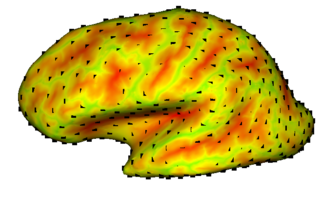2009 Winter Project Week Cortical Correspondence
 Return to Project Week Main Page |
Key Investigators
- UNC: Ipek Oguz, Martin Styner
- Kitware: Will Schroeder
- GE: Xiaodong Tao
Objective
We are developing a cortical correspondence framework that incorporates data from structural images as well as DTI connectivity. The goal at this project week is to create Slicer modules for the entire correspondence pipeline, where the input is surface meshes and local attributes at vertices, and the output is meshes with optimized vertex correspondence.
Approach, Plan
The correspondence pipeline consists of three stages. The first stage scan converts each input surface into a volume, and creates a signed distance map (the surface is the zero-level set of the distance map). It also interpolates the local attributes defined on the mesh vertices to obtain attribute volumes that match the distance volumes. The plan for the project week is to use the VTK point data reader/writer for the attributes.
The particle correspondence framework (the second stage) works on volumes containing distance maps to the surface, as well as attribute volumes. The output of the correspondence tool is a collection of particle locations defined on each surface, such that same index particles correspond across the population. The plan for the project week here is to figure out the best file format for storing this data, and adapting the modules accordingly.
The last stage of the pipeline takes the original meshes and the corresponding particle locations to create new meshes with corresponding vertex locations. The plan for the project week is to create a VTK filter for this task.
Progress
Slicer modules for each of the scan conversion, particle correspondence, and re-meshing stages are already created.
We tested the new python implementation of the stochastic tractography algorithm on our data successfully.
We also discussed, with the Utah group, how to divide the different parts of the pipeline to be as modular as possible, and what the input/output of each module should be.
References
- Cortical Correspondence Using Entropy-Based Particle Systems and Local Features, Oguz I, Cates J, Fletcher T, Whitaker R, Cool D, Aylward S, Styner M, IEEE Symposium on Biomedical Imaging ISBI 2008, pp. 1637- 1640.
- J. Cates, T. Fletcher, and R. Whitaker, "Entropy-based particle systems for shape correspondence," Mathematical Foundations of Computational Anatomy Workshop, MICCAI 2006, pp. 90–99, Oct. 2006.
- J. Cates, T. Fletcher, M. Styner, M. Shenton, and R. Whitaker, “Shape modeling and analysis with entropy-based particle systems,” in IPMI, 2007, pp. 333–345.
